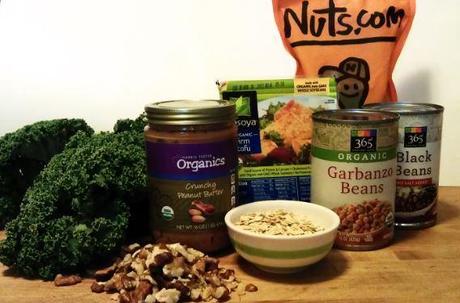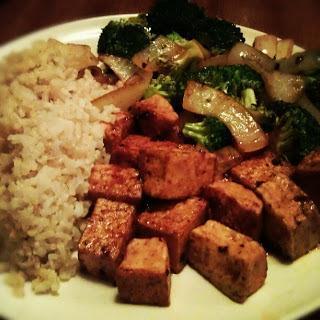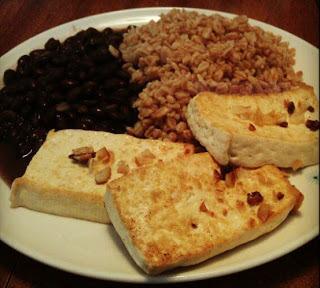I love the great emails I get from new vegans who are pumped and excited to share their story. One such email is from Brandon Frye, author of Forks to Feet. Here he is in his own words.
“Hi, my name is Brandon Frye and I have been completely vegan for about 6 months now. I am from a small town; Winston-Salem, NC. I decided to start a blog dedicated to sharing the benefits of being vegan. As a distance-runner, I have found that a plant-based diet provides me with the nutrition and energy that my body requires. Before going vegan, my body was constantly achy and I always seemed sluggish. Today I have the energy that I always wanted and my body repairs itself much faster. I am so thankful for the people in my life who have shared their stories with me, convincing me that plant-based was the way to go.”
Follow Forks to Feet on Facebook and Twitter. Welcome Brandon!

I am often asked, “Where do you get your protein? You can’t survive without protein.” This is a reasonable question — Especially
coming from those who have been duped by the American food industry. For
many years, companies that sell eggs and meat have been using this as a
marketing strategy. They have conditioned
us to believe that protein emanates exclusively from animal products, and
that we need a lot of it. If you’ve ever
noticed, most egg cartons have some mentioning of protein right on top of the
packaging. The same goes for Eggbeaters. You won’t find Muscle Milk promoting their product with the help of a skinny
little girl either. It’s always some bodybuilder
looking guy, who appears to have been etched from stone. That’s the guy I wanted to look like. Those
were the muscles I wanted. Well, here’s my story and what I have done to
tackle the protein dilemma.
strict regimen. I held myself
accountable for each training run I had planned. I wanted to be absolutely ready come race
day. I began looking into what other
runners were eating. I knew that there
must be some correlation between a runner’s performance and the foods they were
consuming. I saw that runners were on
some of the healthiest diets I had ever seen.
Some ingredients that were mentioned: Whole wheat bread, whole wheat
pasta, bananas, bagels, berries, oranges, quinoa, broccoli, peanuts, almonds,
sweet potatoes, leafy greens, almond milk, etc.
Honestly, I didn’t see myself eating half of that stuff. I ate meat,
like the tough guys. I drank milk,
because it made my bones strong. I
enjoyed the smell of flesh as it cooked on the grill, juicing up to provide me
with that next dose of protein. My
joints were achy, muscles tender, and ankles weak. I was dead set on taking in as much protein
as possible, whether it came from eggs, tuna, chicken, pork, or beef. It didn’t appear to help, but I had always been told that protein repairs damaged muscles.
Didn’t I need the extra protein?
I mean… I had to be running 20 miles a week. Who could survive on just plants
anyway?Fast-forward one yearAs of this writing, I am training for my first full
marathon, logging between 40 and 60 miles a week. My long runs on the weekends are right around
23 miles. My elevation climb has increased. My speed has improved. And, I’m now running in barefoot shoes.To
add insult to injury (pun intended), I am accomplishing this all on a
whole-food plant-based diet. Speaking of
injuries, I haven’t had one in over a year. My turnaround time is quicker and the pain in
my joints have all but disappeared. Now, wouldn’t you think that I would need more
protein to compensate for the added mileage? Little did I know, there is much
more to protein than how many grams we take in.
We need complete proteins; proteins that contain an adequate proportion
of all nine of the essential amino acids.
The essential amino acids include Tryptophan, Threonine, Isoleucine,
Lucien, Lysine, Methionine+Cystine, Phenylalanine+Tyrosine, Valine, and
Histidine. It is perfectly fine to get
these aminos from separate sources to combine into one meal. You can even get these from several meals
throughout the day. (Note: You should be
getting the right proportions of
these essential amino acids. Click here to see a list of the correct proportions and
a list of usable proteins to aid in tissue protein synthesis.) Here are some plant-based foods to include in your diet that
are complete proteins.
- Soybeans
- Quinoa
- Amaranth
- Buckwheat
- Hemp Seed
- Salvia Hispanica (Chia)
- Spirulina (great in green smoothies)

include for added protein: beans, lentils, tempeh, seitan, avocado, broccoli,
spinach, kale, nuts, oatmeal, and non-dairy milk. You can also check out this site for a list of meal options that make up
complete proteins.

That is, not without a calorie deficiency as well. All
plant-based foods have protein. Some
are higher than others and some are more complete than others. As long as we maintain a wide variety of plant-based
proteins, include healthy fats (avocados, olives, nuts, etc.), observe our B12 intake, and get plenty
of calories and carbohydrates, there is no reason why our bodies won’t
flourish. You will find yourself with
more energy than ever and able to heal quicker after strenuous workouts. Remember to include an
array of colors in your meals. That is a
good indication of a complete meal.
